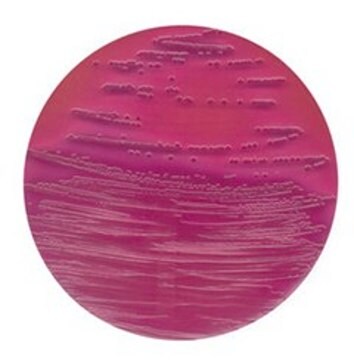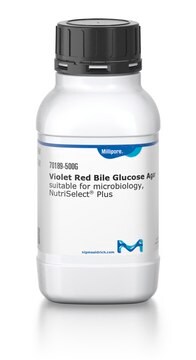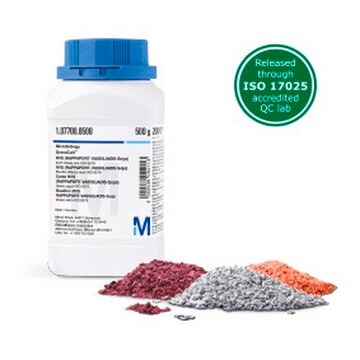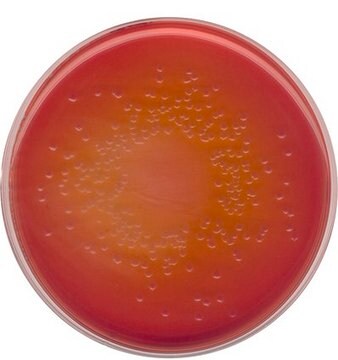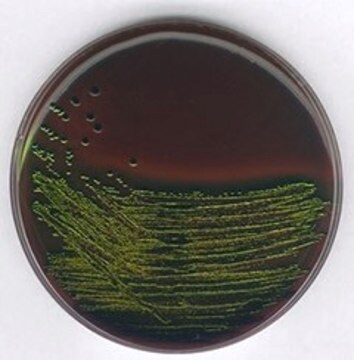1.04030
VRB (Violet Red Bile Lactose)-MUG agar
FluoroCult®, FDA-BAM, suitable for microbiology, for Escherichia coli, for coliforms
Sinónimos:
Coliform selective agar, MUG Violet Red Bile Agar, VRB-MUG agar, Violet Red Bile Agar with MUG, Violet Red Bile Lactose-MUG agar
About This Item
Productos recomendados
agency
FDA-BAM
Quality Level
form
medium granules (dehydrated (DCM))
packaging
pkg of 500 g
manufacturer/tradename
FluoroCult®
storage condition
(Keep tightly closed and dry.)
technique(s)
microbiological culture: suitable
color
pink
pH
7.3-7.5 (25 °C, 39.6 g/L in H2O)
solubility
39.6 g/L (after autoclaving)
bulk density
620 kg/m3
application(s)
food and beverages
microbiology
storage temp.
15-25°C
suitability
Escherichia coli
coliforms
General description
Application
Features and Benefits
- Fluorocult® fluorogenic culture media offer Rapid and Reliable culture testing
- Powerful alternatives to conventional microbiological methods for the rapid and sensitive detection of bacteria
- Offers superior granulated culture media
- Safe and sustainable due to reduced risks associated with fine dust and toxic substance inhalation, resulting in a safer work environment
- Excellent wettability, solubility, and free-flowing properties
- Convenient, with minimal component separation and clumping, even under warm or humid conditions
- High batch-to-batch reproducibility
- Prolonged shelf life of up to five years
- High number of test strains exceeding all regulatory demands
Analysis Note
Appearance (color): dark red
pH-value (25 °C): 7.2 - 7.6
Solidification behaviour (2 hrs., 45 °C): liquid
Growth promotion test in accordance with the current version of DIN EN ISO 11133.
Growth(Escherichia coli ATCC 8739 (WDCM 00012)): good to very good
Growth Escherichia coliATCC 25922 (WDCM 00013): good to very good
Growth (Pseudomonas aeruginosa ATCC 27853 (WDCM 00025)): no limit
Growth (Enterococcus faecalis ATCC 19433 (WDCM 00009)): total inhibition
Growth (Enterococcus faecalis ATCC 29212 (WDCM 00087)): total inhibition
Colonies (Escherichia coli ATCC 8739 (WDCM 00012)): red with precipitation halo
Colonies (Escherichia coli ATCC 25922 (WDCM 00013)): red with precipitation halo
Colonies (Pseudomonas aeruginosa ATCC 27853 (WDCM 00025)): colourless to beige
Fluorescence (Escherichia coli ATCC 8739 (WDCM 00012)): + (poor)
Fluorescence (Escherichia coli ATCC 25922 (WDCM 00013)): +
Fluorescence (Pseudomonas aeruginosa ATCC 27853 (WDCM 00025)): + (greenish)
Incubation: 18 - 24 hours at 35 °C aerobic.
Legal Information
Related product
Storage Class
11 - Combustible Solids
wgk_germany
WGK 3
Certificados de análisis (COA)
Busque Certificados de análisis (COA) introduciendo el número de lote del producto. Los números de lote se encuentran en la etiqueta del producto después de las palabras «Lot» o «Batch»
¿Ya tiene este producto?
Encuentre la documentación para los productos que ha comprado recientemente en la Biblioteca de documentos.
Nuestro equipo de científicos tiene experiencia en todas las áreas de investigación: Ciencias de la vida, Ciencia de los materiales, Síntesis química, Cromatografía, Analítica y muchas otras.
Póngase en contacto con el Servicio técnico